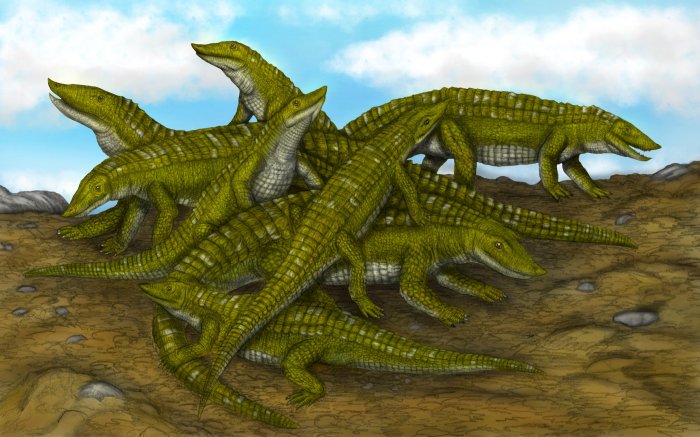Eddie Gonzales Jr. – MessageToEagle.com – A team of researchers have now solved a 150-year-old mystery about aetosaurs -reptiles that died out about 204 million years ago, at the end of the Triassic.
A reconstruction – of the aetosaur assemblage in its habitat. Image: J. Kowalski (drawing) and P. Janecki (coloring). Image source – Rheinische Friedrich-Wilhelms-Universität Bonn
Aetosaurs had a small head and a crocodile-like body. The land dwellers were up to six meters long and widely distributed geographically.
They died out about 204 million years ago, at the end of the Triassic.
In Kaltental near Stuttgart, Germany, an assemblage of 24 Aetosaurus ferratus individuals, only between 20 and 82 centimeters long, was discovered in 1877. Since then, scientists have been puzzling over whether they were juveniles or small adults. A team led by Elzbieta M. Teschner from the University of Bonn has now solved the mystery: Bone examination of two specimens shows that they are juveniles. The results have now been published in the Journal of Vertebrate Paleontology.
Reptiles of the genus Aetosaurus ferratus were discovered in a quarry near Kaltental, now a district of Stuttgart, and were first described nearly 150 years ago. The assemblage of about 24 individuals was dated to be about 215 million years old.
“What was striking was that the total body length was only between 20 and 82 centimeters,” says Elzbieta M. Teschner, who is pursuing a doctorate in paleontology at the University of Bonn while also conducting research at the University of Opole (Poland).
The assemblage of Aetosaurus ferratus skeletons exhibited in the State Natural History Museumin Stuttgart. Credit: E.M. Teschner
“Interestingly, they were also the only fossils found in the area,” she said in a press release.
Oscar Fraas provided the first description of the skeletons in 1877 and suggested that they had washed up together. Sixteen years ago, Rainer R. Schoch of the State Natural History Museum in Stuttgart published a more detailed morphological study. Based on features visible to the naked eye, he determined that they must be juveniles.
Together with Julia B. Desojo, an Argentine paleontologist from CONICET at the Museo de La Plata, they later described the skull of a larger skeleton of another aetosaur species (Paratypothorax andressorum). The find, more than 50 kilometers from Kaltental, could potentially be the adult form of the small aetosaur species known from the assemblage, they surmised.
Paleohistology enables age determination
The assumption only recently became certainty: With the help of the science of tissue growth (paleohistology) it has now become possible to examine the bones of the Kaltental find. “Long bones are a good model for calculating the age of animals because they deposit growth rings during their life that can be counted—similar to the growth rings in tree trunks,” says Dorota Konietzko-Meier, paleontologist from the University of Bonn. Based on this method, the relative individual age of the studied specimens could be determined.
The team, led by Elzbieta M. Teschner, studied the growth of the humerus bones of the smallest and one of the largest specimens from the assemblage.
The results show that both animals were not older than one year. “This young age can be extrapolated for all members of this assemblage,” the doctoral student says. The research team attributes the assemblage of skeletons to juvenile social behavior, which was observed for the first time for aetosaurs. “The animals banded together for some reason,” Teschner says.
“Most likely to increase their chances of survival and deter predators.”
Written by Eddie Gonzales Jr. – MessageToEagle.com Staff








